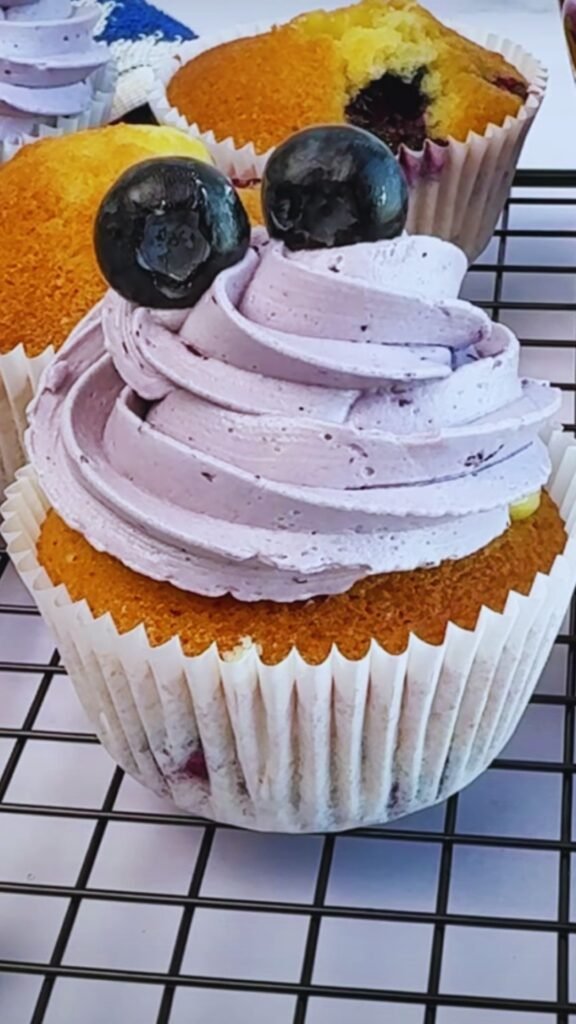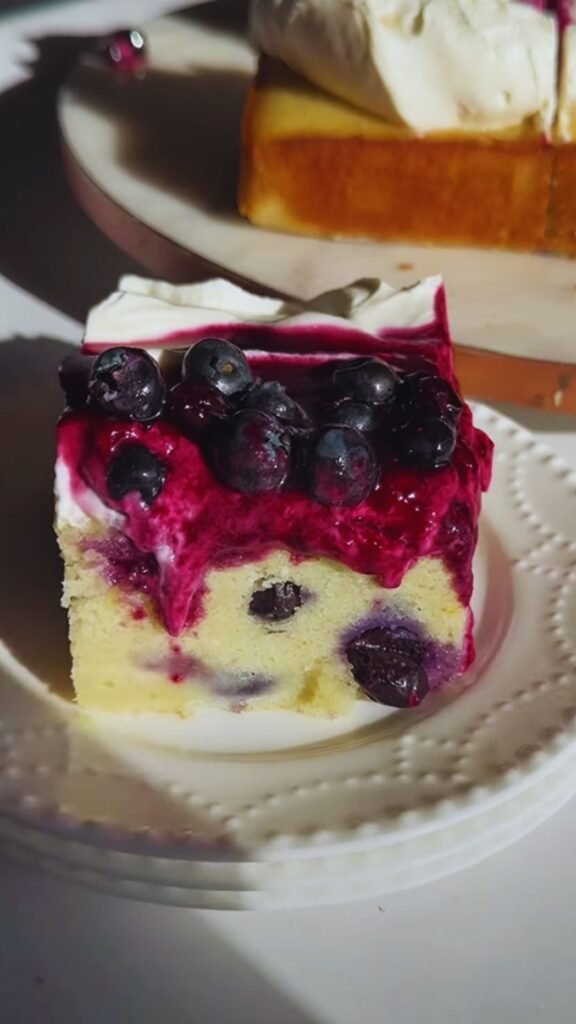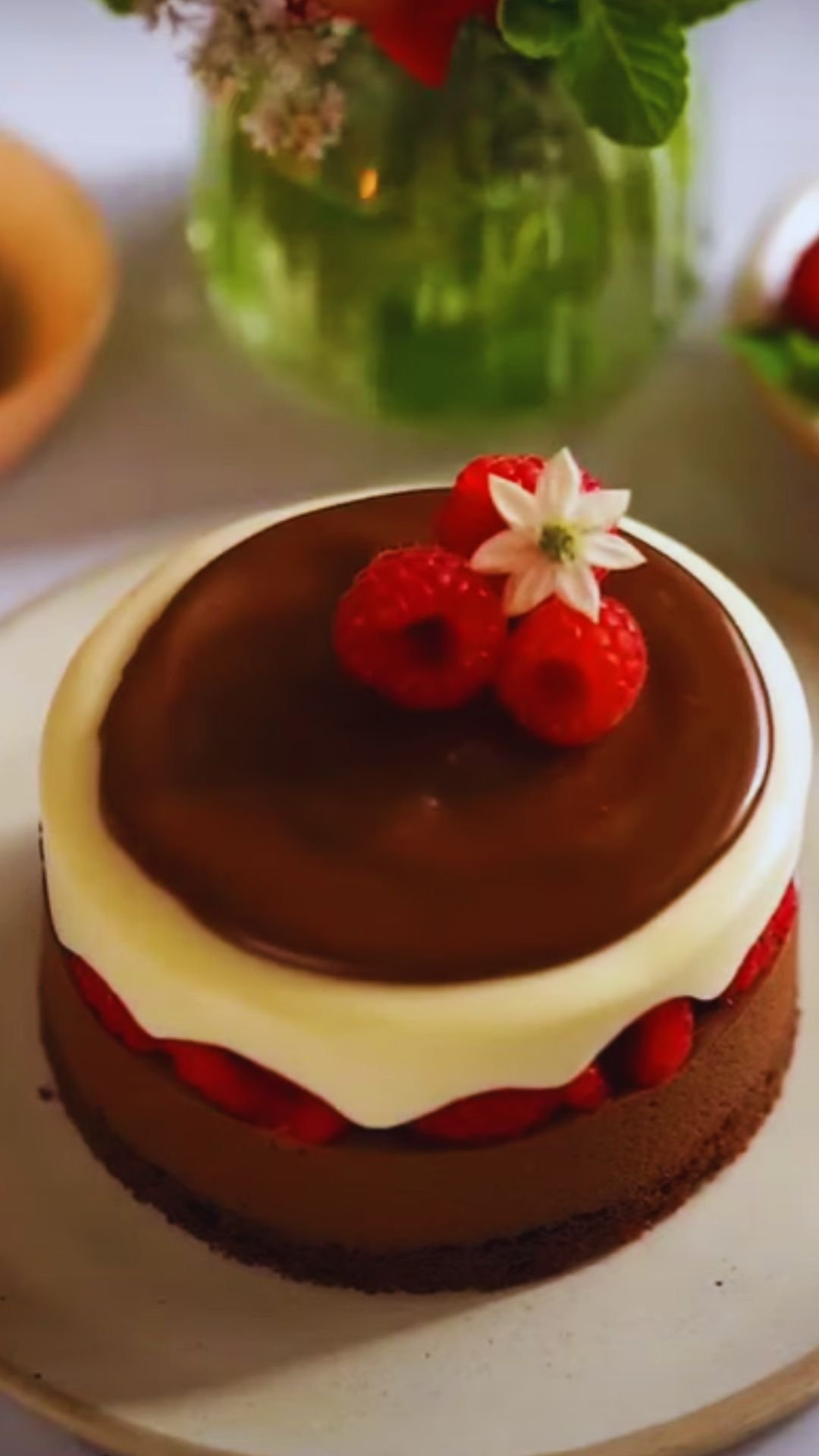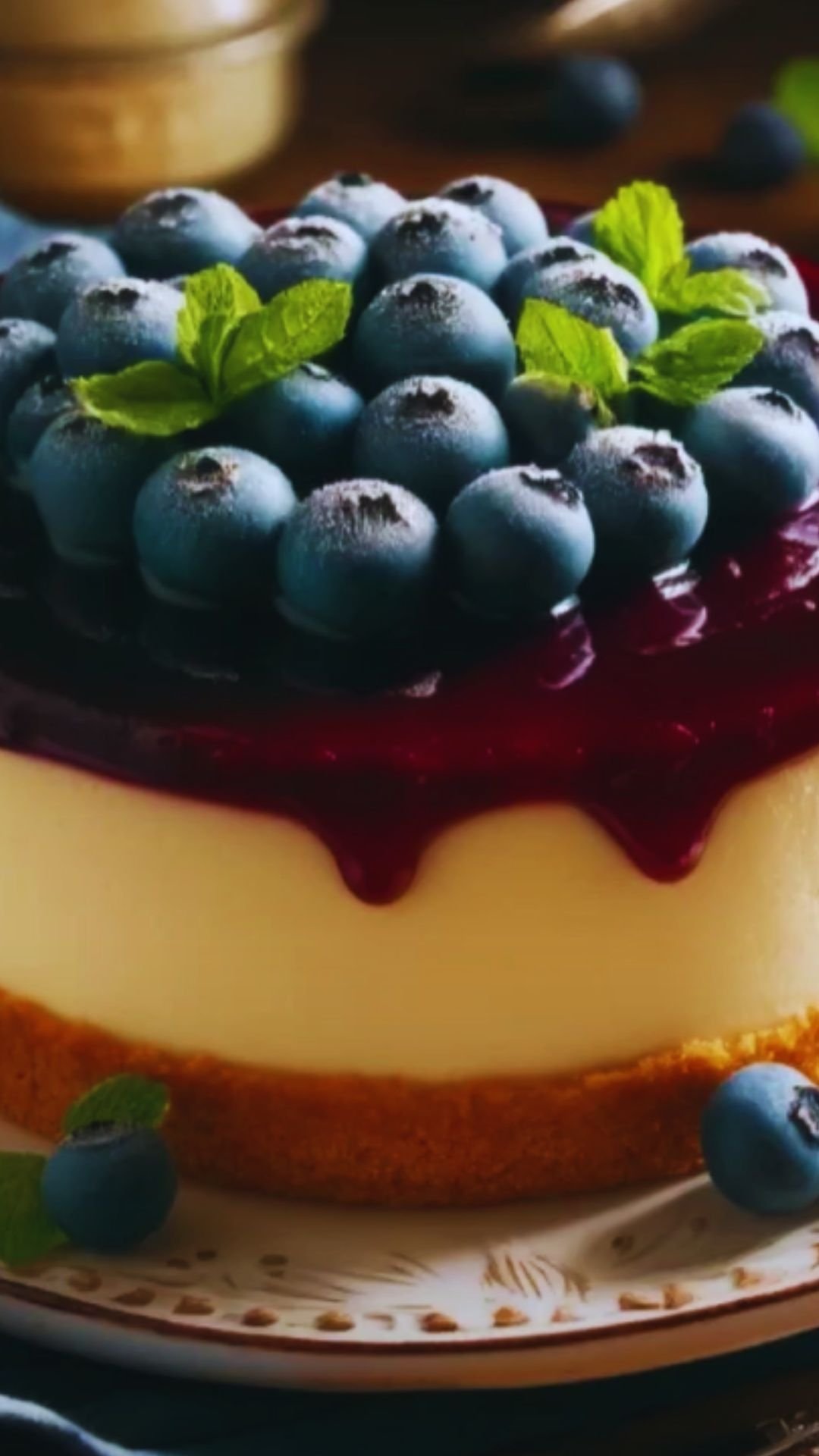There’s something magical about the combination of tart lemon and sweet blueberries that creates a flavor experience unlike any other. When these two wonderful ingredients come together with buttery shortbread and silky mousse, the result is nothing short of spectacular. Today, I’m sharing my absolute favorite summer dessert recipe that’s guaranteed to impress at any gathering: Lemon Blueberry Shortbread Mousse Cake.
I first discovered this dessert during a summer vacation in Maine, where wild blueberries are abundant and lemon desserts are a coastal tradition. After tasting a similar creation at a local bakery, I spent months perfecting this recipe in my own kitchen. The contrast between the crunchy shortbread base, the cloud-like lemon mousse, and the vibrant blueberry topping creates a symphony of textures and flavors that dance on your palate.
What makes this dessert truly special is its versatility. While it looks incredibly sophisticated (and will definitely earn you some “oohs” and “aahs” when you bring it to the table), it can be prepared in stages, making it manageable even for bakers who might feel intimidated by multi-component desserts. Plus, it’s the perfect make-ahead dessert for summer gatherings when you’d rather be enjoying the party than stuck in the kitchen.
Ingredients
For the Shortbread Base
- 225g (1 cup) unsalted butter, softened
- 100g (½ cup) granulated sugar
- 1 teaspoon pure vanilla extract
- ¼ teaspoon salt
- Zest of 1 lemon (about 1 tablespoon)
- 280g (2¼ cups) all-purpose flour
For the Lemon Mousse
- 6 large egg yolks
- 150g (¾ cup) granulated sugar
- 80ml (⅓ cup) freshly squeezed lemon juice (about 2-3 lemons)
- Zest of 2 lemons (about 2 tablespoons)
- Pinch of salt
- 240ml (1 cup) heavy cream, cold
- 8g (2½ teaspoons) powdered gelatin
- 45ml (3 tablespoons) cold water
- 240ml (1 cup) heavy cream, whipped to soft peaks
For the Blueberry Topping
- 450g (3 cups) fresh blueberries (or frozen, thawed and drained)
- 100g (½ cup) granulated sugar
- 2 tablespoons lemon juice
- 2 tablespoons water
- 1 tablespoon cornstarch mixed with 1 tablespoon cold water
- ½ teaspoon pure vanilla extract
For the Decoration (Optional)
- 120ml (½ cup) heavy cream, whipped with 1 tablespoon powdered sugar
- Fresh blueberries
- Fresh mint leaves
- Thin lemon slices or twists
- Edible flowers
Equipment Needed
- 9-inch springform pan
- Parchment paper
- Stand mixer or handheld electric mixer
- Double boiler or heatproof bowl and saucepan
- Rubber spatula
- Fine mesh sieve
- Microplane zester
- Measuring cups and spoons
- Mixing bowls
- Saucepan
- Whisk
- Offset spatula
- Cooling rack

Instructions
Preparing the Shortbread Base
- Preheat your oven to 160°C (325°F). Line the bottom of a 9-inch springform pan with parchment paper and lightly grease the sides.
- In a large bowl or stand mixer fitted with the paddle attachment, cream together the butter and sugar until light and fluffy, about 3-4 minutes.
- Add the vanilla extract, salt, and lemon zest, mixing until well combined.
- Gradually add the flour, mixing on low speed until just incorporated. Be careful not to overmix – the dough should come together but still have a somewhat crumbly texture.
- Press the dough evenly into the bottom of the prepared springform pan. Use the bottom of a measuring cup to smooth the surface.
- Prick the dough all over with a fork to prevent it from puffing up during baking.
- Bake for 25-30 minutes until the edges are lightly golden but the center is still pale. The shortbread should be cooked through but not browned.
- Remove from the oven and let cool completely in the pan on a wire rack. Do not remove from the pan as you’ll be building the rest of the cake on top of this base.
Making the Lemon Mousse
- In a small bowl, sprinkle the gelatin over the cold water and let stand for 5 minutes to bloom.
- In a heatproof bowl, whisk together the egg yolks, sugar, lemon juice, lemon zest, and salt.
- Set the bowl over a pot of simmering water (double boiler setup), making sure the bottom of the bowl doesn’t touch the water.
- Whisk constantly until the mixture thickens and reaches 160°F (71°C) on an instant-read thermometer, about 8-10 minutes. The mixture should coat the back of a spoon and when you run your finger through it, it should leave a clear path.
- Remove from heat and whisk in the bloomed gelatin until completely dissolved.
- Strain the mixture through a fine-mesh sieve into a clean bowl to remove any bits of cooked egg and the lemon zest.
- Let the mixture cool to room temperature, stirring occasionally to prevent a skin from forming, about 15-20 minutes. The mixture should be cool but still fluid.
- In a separate bowl, whip 1 cup of heavy cream to soft peaks.
- When the lemon mixture has cooled, gently fold in the whipped cream using a rubber spatula until just combined and no streaks remain.
- Pour the mousse over the cooled shortbread base in the springform pan. Smooth the top with an offset spatula.
- Refrigerate for at least 4 hours or, preferably, overnight until the mousse is firmly set.
Preparing the Blueberry Topping
- In a medium saucepan, combine the blueberries, sugar, lemon juice, and water.
- Bring to a simmer over medium heat, stirring occasionally.
- Once the berries begin to release their juices and soften (about 5 minutes), add the cornstarch slurry.
- Stir constantly until the mixture thickens, about 1-2 minutes.
- Remove from heat and stir in the vanilla extract.
- Let the topping cool completely to room temperature, stirring occasionally.
- Once the mousse layer is completely set and the blueberry topping is cool, gently spread the topping over the mousse layer.
- Return the cake to the refrigerator for at least 2 hours to set the topping.
Assembly and Decoration
- When ready to serve, run a thin knife around the edge of the springform pan before releasing the sides.
- Carefully transfer the cake to a serving plate.
- If desired, pipe rosettes of whipped cream around the edge of the cake.
- Decorate with fresh blueberries, mint leaves, lemon slices, or edible flowers as desired.

Nutritional Information
| Nutrient | Amount per Serving (1/12 of cake) |
|---|---|
| Calories | 485 |
| Total Fat | 32g |
| Saturated Fat | 19g |
| Cholesterol | 195mg |
| Sodium | 85mg |
| Total Carbohydrate | 47g |
| Dietary Fiber | 2g |
| Sugars | 29g |
| Protein | 5g |
| Vitamin C | 15% DV |
| Calcium | 6% DV |
| Iron | 8% DV |
*Values are approximate and may vary based on specific ingredients used.
Expert Tips for Success
Shortbread Base
- Make sure your butter is properly softened but not melted. It should be cool to the touch but soft enough to leave an indentation when pressed.
- For the best texture, don’t overmix the shortbread dough once you add the flour. Overmixing can develop gluten and make the shortbread tough rather than tender.
- The fork pricks are essential to prevent the shortbread from puffing up unevenly during baking.
- If the edges are browning too quickly during baking, cover them loosely with aluminum foil.
Lemon Mousse
- Fresh lemon juice is absolutely essential for the best flavor. Pre-bottled juice simply doesn’t compare.
- When heating the egg mixture, patience is key. Keep the heat moderate to prevent scrambling the eggs.
- The gelatin amount is carefully calculated for a mousse that’s firm enough to slice cleanly but still luxuriously creamy. Don’t be tempted to reduce it.
- Make sure your heavy cream is very cold before whipping – I even chill my mixing bowl and beaters in the freezer for 15 minutes beforehand.
- When folding the whipped cream into the lemon base, use a light hand and a figure-eight motion to maintain as much air as possible in the mixture.
Blueberry Topping
- Wild blueberries offer a more intense flavor if you can find them, but standard cultivated blueberries work beautifully too.
- The cornstarch slurry must be added to the hot mixture while stirring constantly to prevent lumps.
- Allow the topping to cool completely before spreading it over the mousse to avoid melting the mousse layer.
- For a smoother topping, you can purée half the blueberry mixture and combine it with the whole berries.
General Tips
- All components can be prepared in advance: the shortbread base can be baked 2 days ahead, the mousse can be prepared and set a day ahead, and the blueberry topping can be made up to 3 days in advance and refrigerated separately.
- For the cleanest slices, dip your knife in hot water and wipe it dry between each cut.
- This cake is best served chilled but not ice-cold, so remove it from the refrigerator about 20-30 minutes before serving to allow the flavors to fully develop.

Variations to Try
Berry Variations
- Replace blueberries with raspberries, blackberries, or a mixed berry combination
- Try a strawberry version with sliced fresh strawberries arranged decoratively on top
- Add a handful of dried cranberries to the blueberry topping for extra texture and tartness
Flavor Twists
- Add 1 teaspoon of dried culinary lavender to the shortbread dough for a floral note
- Infuse the lemon mousse with 1 tablespoon of Earl Grey tea leaves (strain before adding gelatin)
- Replace half the lemon juice and zest with lime for a citrus variation
- Add 2 tablespoons of poppy seeds to the shortbread base for a classic lemon-poppy seed combination
Structural Changes
- Turn into individual servings by preparing in a muffin tin lined with parchment strips for easy removal
- Create a layered trifle instead by crumbling the shortbread and layering with mousse and berries in glass cups
- Transform into a rolled cake by baking the shortbread thinner and more pliable, then rolling it around the mousse filling
Make-Ahead and Storage Instructions
Make-Ahead Options
- Shortbread Base: Can be baked up to 2 days ahead and stored at room temperature, well-wrapped.
- Lemon Mousse: Can be prepared and poured over the base up to 24 hours in advance.
- Blueberry Topping: Can be made up to 3 days ahead and stored in an airtight container in the refrigerator.
- Complete Cake: The fully assembled cake can be made 1-2 days ahead of serving.
Storage
- Refrigeration: The completed cake will keep in the refrigerator for up to 5 days. Cover loosely with plastic wrap once the springform pan is removed to protect the surface without damaging the decoration.
- Freezing: This cake freezes remarkably well for up to 1 month. Freeze uncovered until solid, then wrap tightly in plastic wrap and aluminum foil. Thaw overnight in the refrigerator before serving.
Serving Suggestions
- A light dusting of powdered sugar adds an elegant touch just before serving
- Serve with a small dollop of lightly sweetened Greek yogurt for a tangy complement
- For a more substantial dessert plate, add a quenelle of high-quality vanilla ice cream on the side
- Garnish with candied lemon peel for an extra special presentation
- A small pitcher of warm blueberry sauce on the side allows guests to add more if desired
- Serve with a bright, citrusy tea like Earl Grey or a floral tisane
Seasonal Adaptations
Summer
- Use the freshest seasonal berries and consider decorating with edible flowers
- Add a touch of basil or mint to the blueberry topping for a garden-fresh note
- Serve slightly less chilled for a more pronounced flavor profile
Fall
- Add warming spices like cinnamon or cardamom to the shortbread base
- Incorporate a maple swirl into the blueberry topping
- Decorate with candied lemon and orange peel
Winter
- Add a splash of orange liqueur to the mousse for a festive touch
- Use frozen wild blueberries, which are often more flavorful than off-season fresh ones
- Serve with a spiced hot tea or coffee
Spring
- Add a touch of fresh thyme to the lemon mousse
- Decorate with crystallized violets or pansies
- Consider a rhubarb-blueberry combination for the topping
Troubleshooting Common Issues
| Problem | Possible Cause | Solution |
|---|---|---|
| Shortbread is too crumbly | Too much flour or not enough butter | Measure ingredients precisely; press dough firmly into pan |
| Mousse didn’t set properly | Gelatin wasn’t fully bloomed or dissolved; mixture was too warm when folded with cream | Ensure gelatin blooms fully; cool lemon mixture completely before folding |
| Blueberry topping is too runny | Not enough cornstarch; mixture not cooked long enough | Cook until visibly thickened; it will set more when chilled |
| Mousse has tiny lumps | Egg mixture overcooked or gelatin not fully dissolved | Strain mixture thoroughly through fine mesh sieve |
| Cake is difficult to slice cleanly | Knife not clean between cuts; cake too cold | Heat knife in hot water, dry between cuts; let cake warm slightly |
| Shortbread base stuck to pan | Pan not properly prepared | Line bottom with parchment; grease sides well |
| Mousse layer separated from shortbread | Shortbread surface too dry or crumbly | Brush shortbread with thin layer of warm apricot jam before adding mousse |
| Blueberry topping bled into mousse | Mousse not fully set; topping too warm | Ensure mousse is completely set; cool topping to room temperature |
The Science Behind a Perfect Mousse
What separates an ordinary mousse from an extraordinary one lies in the delicate balance of chemical processes at work. The key to the perfect lemon mousse texture involves three critical elements working in harmony:
- Gelatin: Acts as a stabilizing agent by forming a three-dimensional network of protein molecules that trap water, creating a semi-solid structure.
- Acid-Cooked Egg Yolks: When egg yolks are cooked with acid (lemon juice), the proteins denature and coagulate at a lower temperature than they would in a neutral environment. This creates a smooth, custard-like base that contributes richness and stability.
- Whipped Cream: Introduces air bubbles surrounded by fat molecules, creating a light, airy texture. The gelatin network helps maintain these bubbles, preventing the mousse from collapsing.
The perfect mousse has just enough gelatin to hold its shape when sliced but melts effortlessly on the tongue. Too much gelatin creates a rubbery texture, while too little results in a mousse that won’t hold its shape.
The History of Mousse Cakes
The word “mousse” comes from the French meaning “foam,” perfectly describing its airy texture. While savory mousses date back to 18th century France, sweet mousses emerged in the late 19th century when cream and eggs became more accessible to the general population.
The combination of shortbread and mousses in layered desserts gained popularity in the mid-20th century as refrigeration became widespread in home kitchens. The addition of fruit toppings created a balanced dessert that offered multiple textures and flavors in a single slice.
What makes this particular combination so special is how each component enhances the others:
- The buttery, crumbly shortbread provides a sturdy base and contrasting texture
- The cloud-like mousse delivers rich flavor without heaviness
- The fruit topping adds bright acidity and visual appeal
This lemon blueberry version is a modern interpretation of classic flavor pairings, demonstrating how traditional techniques can create thoroughly contemporary desserts.
Frequently Asked Questions
Q: Can I make this dessert without gelatin?
A: Yes, you can substitute agar-agar for a vegetarian alternative. Use about 1 tablespoon of agar-agar powder in place of the gelatin. Dissolve it in the hot lemon mixture and simmer for about 30 seconds to activate it properly. The texture will be slightly different – a bit firmer than with gelatin.
Q: Can I use frozen blueberries for both the topping and decoration?
A: Frozen blueberries work perfectly in the cooked topping, but I recommend using fresh berries for decoration as frozen berries tend to release too much moisture when thawed and can bleed onto the mousse layer.
Q: My mousse isn’t setting properly. What did I do wrong?
A: The most common issue is that the gelatin wasn’t properly bloomed or fully dissolved. Make sure to let the gelatin sit in cold water until it’s fully hydrated and swollen before adding it to the warm lemon mixture. Also, be sure your measurements are precise – too little gelatin won’t provide enough structure.
Q: How far in advance can I make this cake?
A: The complete cake can be made 1-2 days ahead of serving. You can also prepare the components separately: the shortbread base can be baked up to 2 days ahead, the mousse layer can be added up to 24 hours before serving, and the blueberry topping can be made up to 3 days ahead and stored separately until you’re ready to assemble.
Q: Can I make this in a regular cake pan instead of a springform pan?
A: A springform pan is strongly recommended as it allows for easy removal of the cake. If you must use a regular cake pan, line it completely with parchment paper with overhang on all sides to create a sling for lifting the cake out. Chill the cake thoroughly before attempting to remove it.
Q: My lemon curd mixture curdled when I was cooking it. Can I save it?
A: If you catch it early enough, you can save a slightly curdled mixture by immediately removing it from heat and whisking vigorously. For more severely curdled mixtures, strain through a fine-mesh sieve and continue with the recipe. To prevent curdling, use moderate heat and whisk constantly.
Q: How do I know when the shortbread is properly baked?
A: The shortbread should be pale golden at the edges but still relatively light in the center. It should feel set to the touch but not browned. Overbaking will make it too hard once chilled.
Q: Can I reduce the sugar in this recipe?
A: You can reduce the sugar in the shortbread by up to 25% without significantly affecting the texture. The sugar in the mousse, however, is important for both structure and balancing the acidity of the lemon. I wouldn’t recommend reducing it by more than 2 tablespoons.
Final Thoughts
What I love most about this Lemon Blueberry Shortbread Mousse Cake is how it brings together simple ingredients to create something truly extraordinary. The contrast between the buttery shortbread, silky lemon mousse, and vibrant blueberry topping creates a dessert that’s simultaneously sophisticated and comforting.
While it does require several steps, none of them are particularly difficult, and the result is well worth the effort. I find there’s something therapeutic about creating a multi-component dessert like this – each layer represents a different technique and a different facet of baking.
Whether you’re making this for a special occasion or simply because you deserve a magnificent dessert, I hope you enjoy both the process and the final creation. The moment when you release the springform pan and reveal those perfect layers is truly satisfying, matched only by the joy of watching your guests’ faces light up when they take their first bite.
Happy baking!



